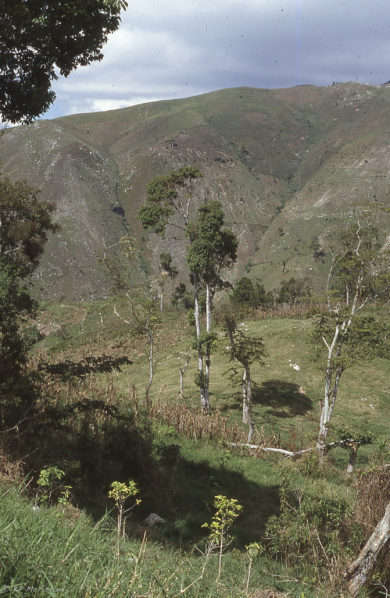
Top panel: forest cover in 2000 in Haiti and the Dominican Republic. Bicknell’s Thrush habitat occurs primarily in areas enclosed by the thick black lines. Bottom panel: Deforestation and afforestation between 2000 and 2014 in Haiti and the Dominican Republic. Each red pixel is an area where forest was cleared during that time period; each green pixel is an area where forest grew back. Data are from Hansen et. al. 2013 (available at: http://globalforestwatch.org
In 2013, a team of scientists lead by University of Maryland professor Matthew Hansen released a high-resolution, global database of forest cover change. This remarkable information, obtained from Landsat satellites, has offered an unprecedented look at the state of the world’s forests. Scientists at VCE are currently using these data to describe changes in the forests of Hispaniola that provide habitat for Bicknell’s Thrush.
The news is not good: between 2000 and 2014, approximately 190 square miles of potential Bicknell’s Thrush habitat was cleared in the Dominican Republic, including areas that are within protected areas such as Parque Nacional Sierra de Bahoruco. That’s about enough forest to support 32,000 Bicknell’s Thrush. During that same time, about 48 square miles of potential habitat for Bicknell’s Thrush was lost to deforestation in Haiti. That forest could have supported about 8,200 Bicknell’s Thrush. Although a smaller area of forest was lost in Haiti, the situation there is arguably more dire given the extensive deforestation which had occurred prior to 2000 (top panel, above). VCE has joined other conservation biologists from across the hemisphere in the Bicknell’s Thrush Conservation Group to help reverse this alarming trend.


As long as the populations of these two countries continue to increase there will always be a problem trying to protect habitat for the Bicknell’s Thrush.
Be that as it may, plenty of opportunities exist to improve habitat protection now, irrespective of human population growth.
So sad! Between this sort of trend and climate change, I wonder how much longer BITH can hold on. But that doesn’t mean we don’t try!
That’s right! Challenges like climate change and deforestation are big and daunting, but we each have to do what we can. We’re currently assisting with a planning process in the Sierra de Bahoruco that has the potential to address some of the major causes of forest loss, which would be a big win for BITH (plus loads of other species) and for people that depend on these mountain forests for clean water. Can’t give up…